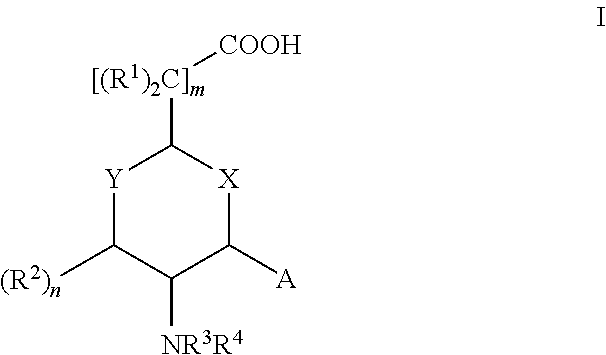Aminocyclohexanes and Aminotetrahydropyrans and Related Compounds As Gamma-Secretase Modulators
a technology of gamma-secretase and aminotetrahydropyrans, which is applied in the field of alzheimer's disease and other neurodegenerative and/or neurological disorders, can solve the problems of no effective treatment for halting, preventing, or reversing the progression of alzheimer's diseas
- Summary
- Abstract
- Description
- Claims
- Application Information
AI Technical Summary
Benefits of technology
Problems solved by technology
Method used
Image
Examples
preparation 1
Methyl {(1R,3S,4R)-4-amino-3-[4-(trifluoromethyl)phenyl]cyclohexyl}acetate (P1)
[0164]
Step 1. Synthesis of tert-butyl {(1R,2S)-4-oxo-2-[4-(trifluoromethyl)phenyl]cyclohexyl}carbamate
[0165]To a cooled (−78° C.) suspension of CuBr-dimethyl sulfide (12.3 g, 59.2 mmol) in THF (50 mL) was added 4-(trifluoromethyl)phenylmagnesium bromide (0.7 M in THF, 169 mL, 118 mmol) drop-wise over 30 minutes. The resulting mixture was stirred at −78° C. for 1 hour. A solution of tert-butyl [(1R)-4-oxocyclohex-2-en-1-yl]carbamate (J. Chem. Soc., Perkin Trans. 1 2000, 329-343) (5.0 g, 20 mmol) in THF (50 mL) was then added drop-wise over 10 minutes. Upon completion of the addition, the reaction was quenched with saturated aqueous NH4Cl solution (125 mL) and allowed to warm to room temperature. The mixture was extracted with EtOAc and the combined organic layers were washed with saturated aqueous NaCl solution and dried over MgSO4. The solvent was removed under reduced pressure and the residue was purifie...
preparation 2
Ethyl (2E,6R)-6-[bis(cyclopentylmethyl)amino]-7-oxohept-2-enoate (P2)
[0170]
Step 1. Synthesis of methyl (4R)-4-[(tert-butoxycarbonyl)amino]-5-hydroxypentanoate
[0171]Borane in THF (1 N, 370 mL, 0.370 mol) was cooled in an ice-salt bath to −5 / −10° C. A solution of N-tert-butoxycarbonyl-D-glutamic acid γ-methyl ester (44.93 g, 0.172 mole) in THF (150 mL) was added drop-wise over 1.5 hours while maintaining the temperature below 0° C. After completion of the addition, the reaction mixture was allowed to stir at 0° C. for 2 hours, then was carefully quenched with AcOH (10% in MeOH, 75 mL). When excess borane had been decomposed, the volatiles were removed in vacuo, and the residue was partitioned between tert-butyl methyl ether and 0.5 N aqueous HCl. The organic phase was washed with saturated aqueous NaHCO3 solution, saturated aqueous NaCl solution, dried over Na2SO4, and filtered. Evaporation of the solvent yielded the title compound as an oily residue (25.16 g, 59%). The material was u...
preparation 3
and Preparation 4
Ethyl {(2S,5R,6S)-5-[bis(cyclopentylmethyl)amino]-6-[4-(trifluoromethyl)phenyl]tetrahydro-2H-pyran-2-yl}acetate (P3) and Ethyl {(2R,5R,6S)-5-[bis(cyclopentylmethyl)amino]-6-[4-(trifluoromethyl)phenyl]tetrahydro-2H-pyran-2-yl}acetate (P4)
[0178]
Step 1. Synthesis of ethyl (2E,6R,7S)-6-[bis(cyclopentylmethyl)amino]-7-hydroxy-7-[4-(trifluoromethyl)phenyl]hept-2-enoate
[0179]To a cooled, −78° C., solution of 4-(trifluoromethyl)phenylmagnesium bromide in THF (200 mL, 0.66 M, 132 mmol) was added a solution of ethyl (2E,6R)-6-[bis(cyclopentylmethyl)amino]-7-oxohept-2-enoate (P2) (18.5 g, 52 mmol) in THF (125 mL) drop-wise over 45 minutes. The reaction was stirred at −78° C. for 10 minutes and then quenched with saturated aqueous NH4Cl solution (125 mL). The mixture was warmed to room temperature and partitioned between water and tert-butyl methyl ether. The aqueous layer was extracted with tert-butyl methyl ether and the combined organic layers were washed with 1 M aqueous Na...
PUM
| Property | Measurement | Unit |
|---|---|---|
| temperature | aaaaa | aaaaa |
| temperature | aaaaa | aaaaa |
| temperature | aaaaa | aaaaa |
Abstract
Description
Claims
Application Information
 Login to View More
Login to View More - R&D
- Intellectual Property
- Life Sciences
- Materials
- Tech Scout
- Unparalleled Data Quality
- Higher Quality Content
- 60% Fewer Hallucinations
Browse by: Latest US Patents, China's latest patents, Technical Efficacy Thesaurus, Application Domain, Technology Topic, Popular Technical Reports.
© 2025 PatSnap. All rights reserved.Legal|Privacy policy|Modern Slavery Act Transparency Statement|Sitemap|About US| Contact US: help@patsnap.com



